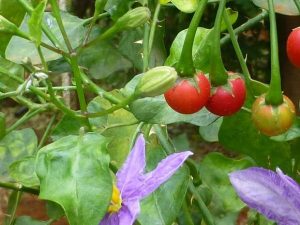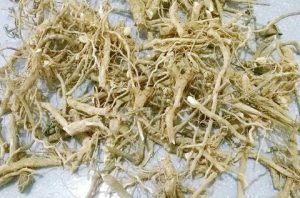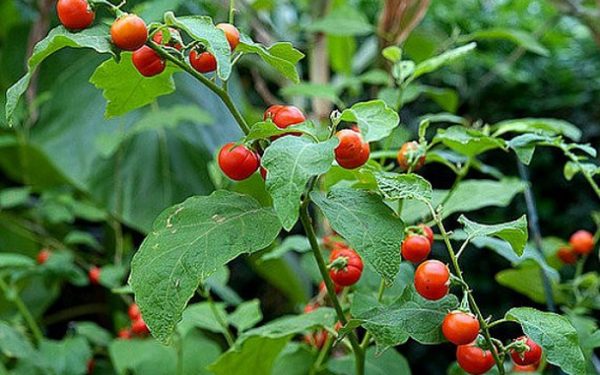Hibiscus plant
Cauliflower is also known by other names such as: sedges, beads, twigs, twigs, twigs, and luu.
Scientific name Solanum hainanense or Solanum procumbens Lour., belongs to the Solanaceae family.
The tree grows wild in many places in our country such as the northern provinces to Hue, Laos, Cambodia.
The prickly pear is a small, many-year-old tree, about 1m long, with many branches, spreading young branches, covered with star-shaped hairs and many yellow curved spines. The leaves are alternately oval or oblong, the leaf blade is shallow, irregular, dark green above, pale below, covered with white hairs, both sides have spines in the main vein, especially the upper surface, petiole also thorny. White flowers grow into cymbal. Berries, smooth globose, long stalks, yellow, red when ripe, yellow seeds.
Parts used are roots (like family roots), strings (like family roots). Roots, twigs and whole fruits, collected year round, washed, chopped, dried or dried. Sometimes used fresh.
The main chemical components such as roots have alkaloids, starch, and flavonoids. It has alkaloids. The plant is used to treat rheumatism, tooth decay, pain in tendons and bones, flu, cough, whooping cough, allergies. Also used to treat venomous snake bites, detoxify alcohol and beer, and prevent motion sickness.
Currently, prickly pear has been researched and proven to be effective in treating viral hepatitis, cirrhosis and supporting the treatment of liver cancer. Day use 16 – 20g in the form of decoction.

Hemp plant cures liver disease (photo collection)
The green leaves are alternate, ovate, oval or elongated. The underside of the leaves is slightly hairy, star-shaped, white but not rough. The upper surface of the leaves has spines.
Cauliflower vine white, yellow pistil. Each flower has 4 to 6 petals. The berries are glossy, round, green when green, red when ripe, about 2cm long. The seeds are yellow, kidney-shaped, and flattened. The prickly pear flower blooms from April to May. The fruit grows from July to September.
Cauliflower grows wild everywhere from low mountains to midlands or coastal plains. Cauliflower is the most popular liver disease treatment in the North of our country. The tree is found in many provinces of Nghe An, Thanh Hoa, Ha Nam and Thai Binh.
Cauliflower has been used for a long time in folklore
The ancients used the roots and stems of prickly pear to treat liver diseases, weak liver, and rashes. Not only that, it is also used to purify and detoxify the body.

Cauliflower roots and stems (collected photos)
Ethnic people in the Central Highlands use Ca gai leo as the first medicinal herb to treat liver diseases. Cauliflower is especially effective in cases of jaundice, abdominal distension, fatigue, and indigestion.
Before drinking alcohol, just nipping the roots of the prickly pear will take a long time to get drunk. When drunk, drinking a decoction of the leaves and stems of prickly pear will quickly sober up and not be tired.
Efficacy of medicinal herbs of Ginkgo biloba in treating liver diseases from a modern scientific perspective
What effect does the prickly pear plant do is a matter of interest to many scientists. The plant has been interested and researched by scientists since the 1980s. So far, there have been many research topics on the plant, including 2 state-level research projects , 4 doctoral theses and many other grassroots topics. Scientific research topics have elucidated the active ingredients, effects, and effectiveness of the medicinal plant Ginkgo biloba for liver disease.
Supportive effect in the treatment of viral hepatitis, especially hepatitis B virus
There are a number of effective remedies for hepatitis B with prickly pear. Active ingredients in the plant, typically glycoalkaloids, have the effect of supporting the treatment of viral hepatitis, especially hepatitis B, enhancing immunity and improving symptoms of the disease:
– In 1999, the thesis of the doctorate of medicine: “Some clinical features, liver superstructure and initial effectiveness in the treatment of patients with chronic hepatitis B virus active with the drug Ca prickly pear” of the doctor . Trinh Thi Xuan Hoa has clinically tested a product containing prickly pear at the 103 Military Hospital, showing that patients after using the product containing Ginkgo biloba have significantly improved symptoms of anorexia, fatigue, and yellowing. skin, liver enzymes returned to normal quickly after 2 months. Especially after 3 months of use, most of the patients had a marked reduction in the concentration of virus in their blood, even a negative case was recorded.
The effect of slowing the progression of cirrhosis

Active ingredients in Cayenne pepper help slow down the progression of cirrhosis (collection photo)
The active ingredients in the plant, especially glycoalkaloids, have the effect of slowing down the progression of fiber and reducing the level of early fiber.
– Two scientific research works from 1987 to 2000 of the Central Institute of Medicinal Materials are “Study on the inhibitory effect on the fibrosis process of Cauliflower on experimental liver cirrhosis model” and “Study on the effect on collagenase of Cirrhosis”. The plant has been announced as a medicinal herb that has a significant effect on preventing cirrhosis of the liver.
In addition, there are many other studies that prove this.
The effect of prickly pear to treat liver disease in liver detoxification, lowering liver enzymes
The active ingredients in the extract of prickly pear are very good for treating liver diseases. These active ingredients have a hepatoprotective effect. Not only that, they also help limit damage to liver cells and lower liver enzymes quickly.
In 1998, in the doctoral thesis of medicine by Nguyen Phuc Thai by Assoc. Nguyen Khac Hai and Prof. Dr. Nguyen Phuc Hung showed that: The extract from the plant has a significant effect on protecting the liver under the toxic effects of TNT, which is clearly shown by limiting the destruction of liver cells. ; Limit the increase in liver weight due to TNT toxicity and reduce the liver injury manifestations on microscopy.
Anti-oxidant effect, inhibiting some cancer lines
The whole extract from the prickly pear plant has a very good antioxidant effect. It is also anti-inflammatory, reduces oxidative damage in the liver, and protects the liver.
– In the study of Dr. Nguyen Thi Bich Thu and her collaborators about Cayenne pepper have announced that the whole extracts from the plant and Glycoalcaloids have significant antioxidant effects of 47.5% and 38.1%, respectively.
– The extract has also been shown to inhibit some viral cancer cell lines such as liver cancer cells (Hep 3B, PLC/PRF), cervical cancer…. In addition, it also inhibits viral oncogenes.
And there are many other scientific studies that have proven that prickly pear is very effective in treating liver disease. Cauliflower helps to stimulate the regeneration of liver cells, has strong anti-inflammatory, and lowers liver enzymes very well.
From the above research results, it can be seen that prickly pear is one of the most intensively and methodically researched medicinal herbs with the benefits of supporting the treatment of hepatitis, preventing progression of cirrhosis, lowering liver enzymes. , detoxifies and protects the liver very effectively.

